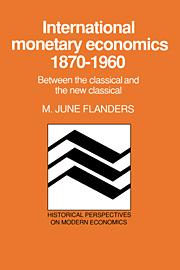15 - The keynesians II
Published online by Cambridge University Press: 12 October 2009
Summary
Early Metzler: formal I
An early formal development of the keynesian model of an open economy was Lloyd Metzler's thesis (submitted at Harvard University in 1942), from which two chapters were published in the journals. The two papers are clearly of a piece. They are different in style, as befit the respective journals (Econometrica and the Journal of political economy) at that time, but in content they are both studies in the application of keynesian analysis to the open economy problem. Distinguishing between various channels of adjustment, price (including price level, exchange rate, and interest rate changes), real income effects, and Ohlin-type expenditure and purchasing power changes, he concentrates his attention on the real income effects. While not as rich as Machlup's study (see below) in the proliferation of disturbances and varying institutional environments, Metzler's two papers here are spare and elegant; they constitute a breakthrough in the formal application of the keynesian apparatus to the open economy.
The model is the same in both – a simple two-country keynesian model, in which consumption, imports, and investment are lagged functions of income. The first paper treats the issue of the dynamic stability of income in an open economy. If any parameter of the model changes, will income converge to a new equilibrium, given that the current account is unconstrained? If stable, what will the new equilibrium for the two countries, and the world, look like?
- Type
- Chapter
- Information
- International Monetary Economics, 1870–1960Between the Classical and the New Classical, pp. 285 - 310Publisher: Cambridge University PressPrint publication year: 1990

